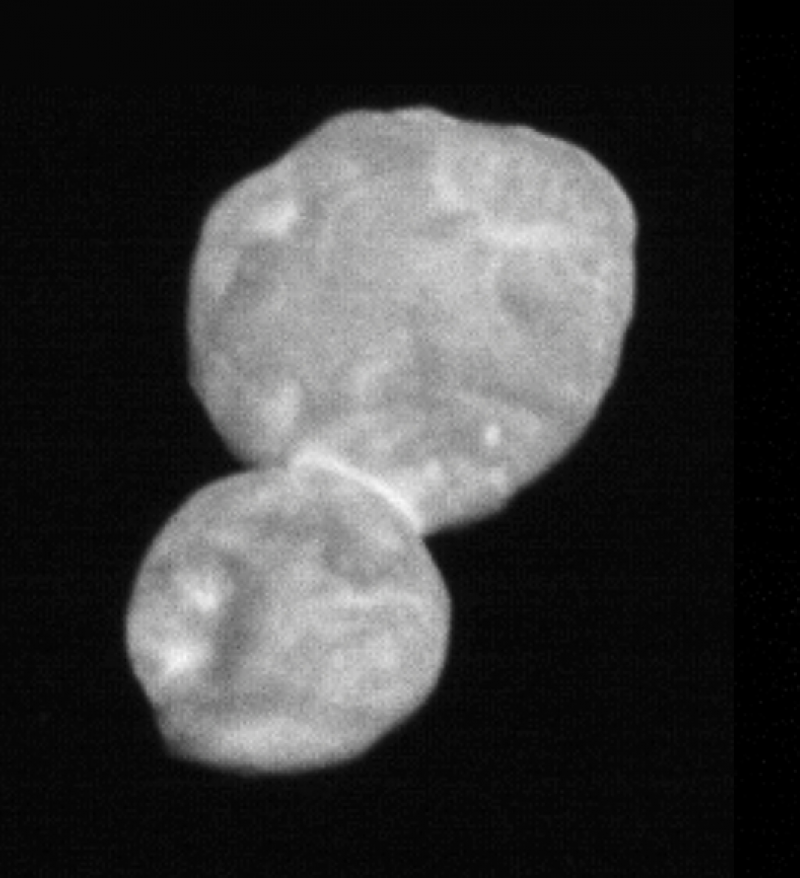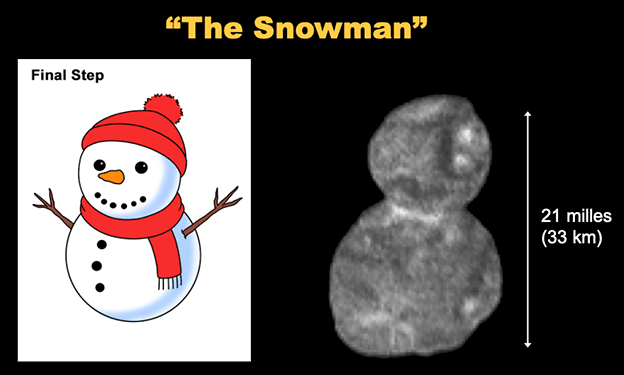New Horizons probe, due at Ultima Thule asteroid Jan.1st, Has Already Found its First Mystery
Message boards :
Science (non-SETI) :
New Horizons probe, due at Ultima Thule asteroid Jan.1st, Has Already Found its First Mystery
Message board moderation
| Author | Message |
|---|---|
|
Michael Watson Send message Joined: 7 Feb 08 Posts: 1387 Credit: 2,098,506 RAC: 5 |
It's been believed for some time that the asteroid Ultima Thule is either quite elongated in shape, or that it consists of two distinct parts, either in physical contact, or closely orbiting one another. When New Horizons finished with its work at Pluto, Ultima Thule was selected as its next target. Asteroids of such shapes are expected to show notable variations in reflected light, as they rotate. First, the narrow end points sunward, reflecting relatively little light, then the broad side comes around and much more light is reflected. New Horizons is nearly to its goal, but no variations in the light curve, as they call it, can be found. Astronomers are quite mystified by this. All the proposed explanations strike them as quite unlikely. The most reasonable-sounding of these explanations is that the asteroid, or its halves are spinning about each other at right angles, from our point of view. This would cause very little change in the light level, over time. The problem here is that the asteroid would have to be oriented just-so for this to work. Given all possible orientations, this just isn't very likely. We should have a better idea of what is really happening with Ultima Thule in just over a week. The first images from New Horizons are expected to reach us on Jan. 1st or 2nd. |
 Lynn Lynn Send message Joined: 20 Nov 00 Posts: 14162 Credit: 79,603,650 RAC: 123 
|
Thanks for posting this. I heard about this mystery last night. https://www.nasa.gov/press-release/nasa-announces-media-activities-for-new-horizons-new-year-s-kuiper-belt-flyby Nov. 7, 2018 MEDIA ADVISORY M18-167 NASA Announces Media Activities for New Horizons’ New Year’s Kuiper Belt Flyby  NASA is inviting media to cover the farthest spacecraft flyby in history on Jan. 1, 2019, when the agency’s New Horizons spacecraft encounters the Kuiper Belt object nicknamed Ultima Thule. Flyby events will take place from Dec. 29 to Jan. 4 at the base of New Horizons operations, Johns Hopkins University Applied Physics Laboratory (APL) in Laurel, Maryland. If this is of alien origin that would amazing. edited for image. |
|
Michael Watson Send message Joined: 7 Feb 08 Posts: 1387 Credit: 2,098,506 RAC: 5 |
Yes, it would be amazing! The recently released NASA Technosignatures Workshop Report has a section on 'Solar System Artifacts and Interlopers'. Writing of extraterrestrial probes, they write: 'If such probes exist, it is possible that they might remain in the solar system, either by design or gravitational capture. Searches for minor planets are naturally also searches for such objects, which might be distinguished by their anomalous orbits, spectra or colors.' Besides it'd odd monotonic light curve, which at least hints at the possibility that Ultima Thule may not be rotating at all, it's also been realized that it has an unusually low eccentricity, low inclination orbit of the Sun, as compared to other Kuiper Belt objects. |
|
Michael Watson Send message Joined: 7 Feb 08 Posts: 1387 Credit: 2,098,506 RAC: 5 |
Because Ultima Thule is relatively small ( 25--45 kilometers in diameter), we really haven't had a good look at it yet. All the images showing it as anything more than a tiny dot are merely artists' interpretations, based on the assumption that it's a binary asteroid (one made of two connected lobes, or two separate objects in close orbit of one another. No one knows, or will know what it really looks like until New Horizons has flown past the object and transmitted images of it back to Earth. If all goes well, this should occur on January 1st, just five days from now. |
 Gordon Lowe Gordon Lowe Send message Joined: 5 Nov 00 Posts: 12094 Credit: 6,317,865 RAC: 0 
|
|
 Lynn Lynn Send message Joined: 20 Nov 00 Posts: 14162 Credit: 79,603,650 RAC: 123 
|
I think it will be something from the early universe? We will wait & see. |
 Lynn Lynn Send message Joined: 20 Nov 00 Posts: 14162 Credit: 79,603,650 RAC: 123 
|
1st. This link was first posted earlier. HTML links change. My little bug is this, don't trust NASA. https://news.yahoo.com/mysterious-deep-space-world-ultima-211741618.html Ultima Thule — an uncharted world over 4 billion miles away — is coming into view. On Monday, planetary scientists released a fuzzy image of Ultima Thule, snapped the day prior by the New Horizons exploration spacecraft from some 1.2 million miles away. Previously, New Horizons swooped by Pluto in 2015, capturing the icy, mountainous world in unprecedented detail. Mysterious deep space world Ultima Thule already looks weird — and we've only had a glimpse. It looks elongated.? |
W-K 666  Send message Joined: 18 May 99 Posts: 19393 Credit: 40,757,560 RAC: 67 
|
01/01/2019 15:32 01/01/2019 15:40 https://spaceflightnow.com/2018/12/30/new-horizons-ultima-thule-mission-status-center/ |
 Lynn Lynn Send message Joined: 20 Nov 00 Posts: 14162 Credit: 79,603,650 RAC: 123 
|
Sorry guys. Ultima Thule, is shaped like Santa. See:  |
W-K 666  Send message Joined: 18 May 99 Posts: 19393 Credit: 40,757,560 RAC: 67 
|
It's a snowman.  |
 Lynn Lynn Send message Joined: 20 Nov 00 Posts: 14162 Credit: 79,603,650 RAC: 123 
|
NASA reveals best-yet image of twin space rocks Ultima Thule NASA’s 2019 started off with a bang as its New Horizons probe zipped by the most distant object mankind has ever tried to visit, a strange space rock known as Ultima Thule. Scientists quickly discovered that Ultima Thule isn’t one object, but two, making it the first contact binary ever studied in such detail. https://bgr.com/2019/01/25/ultima-thule-photo-new-horizons-image/ edited: Click url for image. |
|
Michael Watson Send message Joined: 7 Feb 08 Posts: 1387 Credit: 2,098,506 RAC: 5 |
The large circular marking on the larger of the two lobes of this object has provoked a good deal of comment and speculation. It doesn't appear much like the rim of a crater. Two portions of its circumference, roughly opposite each other, appear to be made up of double lines. The circle appears somewhat lopsided, but it approximately mirror-symmetrical on either side of a line that crosses the center of the circle and points toward the cleft on one side of the 'neck' region connection the larger and smaller lobes . |

©2024 University of California
SETI@home and Astropulse are funded by grants from the National Science Foundation, NASA, and donations from SETI@home volunteers. AstroPulse is funded in part by the NSF through grant AST-0307956.
 The mind is a weird and mysterious place
The mind is a weird and mysterious place